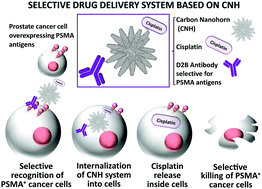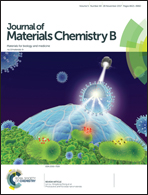Targeted killing of prostate cancer cells using antibody–drug conjugated carbon nanohorns†
Abstract
The ability of carbon nanohorns (CNHs) to cross biological barriers makes them potential carriers for delivery purposes. In this work, we report the design of a new selective antibody–drug nanosystem based on CNHs for the treatment of prostate cancer (PCa). In particular, cisplatin in a prodrug form and the monoclonal antibody (Ab) D2B, selective for PSMA+ cancer cells, have been attached to CNHs due to the current application of this antigen in PCa therapy. The hybrids Ab–CNHs, cisplatin–CNHs and functionalised-CNHs have also been synthesized to be used as control systems. The efficacy and specificity of the D2B–cisplatin–CNH conjugate to selectively target and kill PSMA+ prostate cancer cells have been demonstrated in comparison with other derivatives. The developed strategy to functionalise CNHs is fascinating because it can allow the fine tuning of both drug and Ab molecules attached to the nanostructure in order to modulate the activity of the nanosystem. Finally, the herein described methodology can be used for the incorporation of almost any drugs or Abs in the platforms in order to create new targeted drugs for the treatment of different diseases.



 Please wait while we load your content...
Please wait while we load your content...